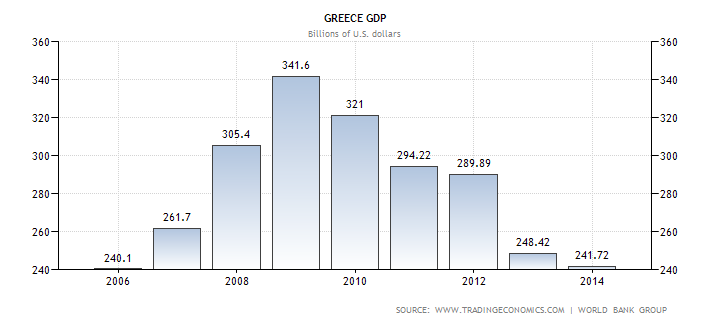Financial assistance (bailout) to
Greece (2010, 1st quarter)
Greece is a member of the Eurozone union. Several factors led to the decision by the International Monetary Fund to finance the country as a way of bailing its failing economy during the recession. As a recovery package, the IMF offered Greece a monetary aid of about €110bn (Elliott, 2010). However, Greece being a member of the eurozone union could not achieve fast economic growth. This was because the country could not have devalued its currency or cut its interest rates to enhance export-led growth. This was the only way that financial recovery and economic growth would have been accelerated.
To mitigate the financial crisis, the government increased the VAT to offset the national debt. However, the country was not benefiting from economic growth at the same time (Elliott, 2010). The Gross Domestic Product of Greece has been declining since 2010 as shown in the graph below

On the other hand, the rate of employment was at its highest point at 28% in 2013 (Elliott, 2010). This was double the euro zone’s record of about 12% in the same period (Elliott, 2010). In 2010, the inflation rate began to decline as well and the statistics are as follows, Jan 2010 2.4%, Feb 2010 2.8%, Mar 2010 3.9% (Elliott, 2010).
Iceland (2008, 4th quarter)
Iceland was the first victim of the dreadful economic crisis in 2008 (Forelle, 2012). However, the unemployment rate in the country is improving and the immigration rate is also reducing (Forelle, 2012). One of the advantages that the country has over the rest of the Euro zone’s members is the ability to devalue its currency. This enabled export-led growth hence accelerating its financial recovery (Forelle, 2012). The ability to devalue its currency helped the country to turn its trade shortage into financial excesses.
Iceland benefited from the IMF funding because it had its monitory policy, and an independent banking system, unlike the eurozone members. The country did not rush into expenditure cuts like the rest of the eurozone members. On the contrary, the government increased its social-farewell payment to the poor. By increasing social-farewell payment, the rate of spending increased, and ultimately the effects of the economic crisis were cushioned. Iceland’s GDP rose to 59% of its export and by March the country had begun paying its debt way before schedule (Forelle, 2012).
Ukraine (2014, 2nd quarter)
Since last year, Ukraine’s industrial activities have reduced by 21.4 % according to the statement given by the National Bank (Dorovskykh, 2014). Almost 60% of the country’s GDP is consumed by foreign debt (Dorovskykh, 2014). To lessen the impact of its economic tribulations, the Ukrainian Government has been trying to cut down on its spending through its public sector budget. The country was depending on tax revenues that had increased by 9 percent (Dorovskykh, 2014). In the Ukrainian economy, 30% of the total revenue is collected from sales tax.
Military operations are the greatest consumers of the country’s resources hence causing the industrial activities to reduce by 4.6 percent (Dorovskykh, 2014). The rate of employment is on its record low since the industrial operations are halted and ultimately the GDP is projected to decrease further. If the situation is not solved soon, the country is likely to face tough economic experiences in the future. Key economic sectors like the heavy industry and the export of minerals and rolled Metals have been destabilized completely (Dorovskykh, 2014).
Hungary (2008, 4th quarter)
Hungary has an open export policy and this is why the global crisis had a great impact on its local economy. The economy was affected by the financial crisis leading to a 6.3% shrinking of the economy (Hungarian Chamber of Commerce and Industry, 2015). The government introduced changes that were meant to reduce businesses and personal income tax but on the other hand impose “crisis taxes” (Hungarian Chamber of Commerce and Industry, 2015). This mostly affected financial institutions, the energy sector, and telecommunication companies (Hungarian Chamber of Commerce and Industry, 2015). By 2010, the economy was already getting back to normalcy. This was greatly influenced by the boost gained from its exports to Germany (Hungarian Chamber of Commerce and Industry, 2015). This strategy worked perfectly for Hungary and the country experience economic recovery a few years later.
Careful planning by the government caused the IMF to remove the country from the Excessive Deficit Procedures (Hungarian Chamber of Commerce and Industry, 2015). The growth rate was estimated to be 1.4% by the year 2011. The GDP deficit was reducing at an enviable rate of 3% (Hungarian Chamber of Commerce and Industry, 2015). By 2013, Hungary had exited the economic recovery stage and this was all because of the plans laid out in the 4th quarter of 2008. The rate of employment began to rise as a result of the improved exports window. Due to this, the GDP heightened and the currency value also began to regain its economic strength (Daniels, Radebaugh & Sullivan, 2015). As the economy recovered slowly the inflation rate was also improving. However, in the 4th quarter of 2008, the rate was very high due to the financial meltdown at that time.
References
Daniels, J. D., Radebaugh, L.H., & Sullivan, D. P. (2015). International business: Environments and operations (15th ed.). Upper Saddle River, NJ: Pearson Education.
Dorovskykh, O. (2014). Costly War: Is Ukraine’s Economic Recovery Feasible? Web.
Elliott, L. (2010).This Greek bailout is not a recovery plan – it is an economic death spiral.Web.
Forelle, C. (2012). In European Crisis, Iceland Emerges as an Island of Recovery. Web.
Hungarian Chamber of Commerce and Industry: The Economy. (2015). Web.